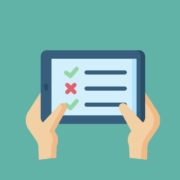How to Make Sure an Electronic Signature is Valid – Whiteboard [VIDEO]
If you’re trying to determine how you can use technology to make the employee onboarding process paperless, then there are some things you should know about e-signatures. In today’s Whiteboard Chat, Jeff Hallam discusses the elements that are included in a legitimate electronic signature.
Video Transcript:
Hi! Today we’re going to talk about electronic signatures. And this is something that comes up a lot in today’s world as more and more organizations are looking for solutions that can help expedite collecting signatures, and really, the idea today is to make sure that we can help you better understand some of the essential items that have to be there in order for an electronic signature to be as valid as a regular physical signature.
And again as a quick precursor, none of this is meant to be legal advice. If you have more detailed questions, I would always recommend that you seek your attorney of choice. But hopefully this will at least give you a pretty good checklist of things to consider as you go down this path. So really everything starts with a piece of legislation passed back in 2000 called the E-Signature Act. More commonly know as the E-Sign Act. So as you go down this path you’ll probably hear that terminology used and really all that was designed to do was to lay out a common set of protocols that all providers and organizations could use to make sure that key elements of an electronic signature were consistent across the board.
So really, what we’re going to start with are kind of just these four common things that have to be present in order to make sure that you are in compliance from an e-Sign Act perspective.
So the first one is review. As you would expect with any kind of typical physical document, nobody’s going to sign that until they actually have a chance to see what it is that they are signing. The same thing applies with electronic signature. You have to give the person who’s being asked to sign the document access to that document so they can confirm what’s on it, and that they can indicate that they are in agreement with that. Pretty standard, but again, just to make sure that that would be part of what’s offered and to check on that.
Secondly, and this is really more at the core of the technology side of things, is the ability to prove that the signature is unique and verifiable. And, there are different ways to do this and I’m going to hit on more of the best practices approach. Really there are three elements involved in making sure that this signature becomes unique and verifiable. Number one, you have to be able to record something that constitutes a signature. And, that can be anything from checking a box, filling their name into a box of text on a screen, all the way down to an actual mouse pad signature where somebody would attempt to replicate their signature electronically. Whatever approach somebody uses doesn’t really matter at that point as long as that is recorded.
Secondly, you’re typically going to want to make sure that there’s a date and a time stamp to that signature so that it can be found and tied back to when this actually occurred. And then finally, in most instances you’re going to want to record the IP address of the computer or the device where someone was when they issued that signature. And now as you combine all three of those elements, it is very easy to go back and confirm that the person who appeared to sign the document actually did.
Thirdly, we get to consent. If there are documents that are longer, or a little more complicated, and/or those that have repercussions if certain conditions aren’t met or rules aren’t followed, its always a good idea, again best practices-wise, to have a way to make sure that the person is really clear on what that consent means. So, for instance on the I-9 form, which is something we run into very frequently, there are certain penalties that may be imposed if you’re found to have been untruthful in documenting somebody’s citizenship status. Well, as the person being asked to sign off on that, while it is in the document, the I-9 is several pages long. So, what you might do in those instances is look for an opportunity to either highlight those key areas so its very clear to the person and those are called out; or, perhaps even bring a copy of those key elements down into the signature area where they are being asked to sign so that its very clear again that they understand what it is exactly that they are consenting to at that point.
And then finally, access and change. This kind of works both sides of the street – access means the person that we have asked to sign the document has to have the ability after that transaction is complete, to download and access a copy of that for their records. Print, save, whatever it might be. Likewise, on the other side of the street, the group that originated the transaction, is prohibited from making any changes to that signed agreement unless its approved by the person that was asked to sign it in the first place.
And again, nothing different than what you would see in a regular contract or signing arrangement physically, but again, making sure that these four elements are all there, and that those criteria exist, and that whatever vendor or developer you’re working with can prove those items will make sure that you can stay in compliance and that your electronic signatures are every bit as valid as a physical signature. Thanks!
For more information about how ExactHire’s employee onboarding software utilizes e-signatures, please visit our resources section or contact us today.








